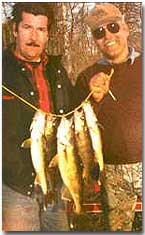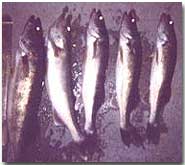Catchin' Those Early Season Walleyes
Catchin' Those Early Season Walleyes
By Steve Huber
 When you live where I do (northern Wisconsin), in February, it's tough to picture walleye fishing without images of tip-ups springing to mind. Not for me, you see, I'm one of the crazies that is trailering a boat through the snowstorms, visions of walleyes dancing in my head. When I'm at a gas station fueling the boat, I get lots of comments; "Must be nice to be heading south this time of year," "On your way to Florida?" etc. When I tell these misguided folks that "Nope, I'm going walleye fishing", they look at me like I've slipped my drag a bit. I don't know about you but I'd much rather be sitting on a nice, warm, comfortable padded seat, on a carpeted boat platform than standing on the ice. And, this time of year, the walleyes are snapping! The hardest part of all of this is finding a boat landing that hasn't been snowplowed shut. When you live where I do (northern Wisconsin), in February, it's tough to picture walleye fishing without images of tip-ups springing to mind. Not for me, you see, I'm one of the crazies that is trailering a boat through the snowstorms, visions of walleyes dancing in my head. When I'm at a gas station fueling the boat, I get lots of comments; "Must be nice to be heading south this time of year," "On your way to Florida?" etc. When I tell these misguided folks that "Nope, I'm going walleye fishing", they look at me like I've slipped my drag a bit. I don't know about you but I'd much rather be sitting on a nice, warm, comfortable padded seat, on a carpeted boat platform than standing on the ice. And, this time of year, the walleyes are snapping! The hardest part of all of this is finding a boat landing that hasn't been snowplowed shut. If you have a free flowing river nearby with an open landing, you just might be near the hottest walleye fishing you've ever experienced! Late last fall, the river walleyes migrated upstream to the deepest holes that they could find. Usually, these deepest spots are below dams and the fish concentrate here all winter, staying until spawning time. Don't expect the fish to be real aggressive and charge a fast moving bait though, this is finesse fishing at its finest. You rarely will get a "slamming" hit, usually, it's just extra weight on the line or something "just feels different." When this happens, SET THE HOOK! Light tackle, small jigs and minnows are the ticket. Traditional slip bobbers will work great here too if the current flow isn't too great. What I usually do is slowly motor around the pool below the dam, watching my locator, looking for concentrations of fish, humps, holes and changes in bottom composition. When I find these, I'll mark them with a float and anchor up-current, casting distance away. Ideally, if I can find a hump coming from 20 feet of water up to 8 to 12 feet with fish on it, I'll start there. These fish are usually there feeding and are easier to catch. It seems that the fish laying in the deeper holes are inactive or neutral at best and are more difficult to catch. The first thing that I do is rig a 6 foot to 6 1/2 foot light spinning rod spooled with 10 pound test FireLine. I use FireLine for several reasons. It's limp, casts great in cold weather and because of the small diameter, the current doesn't push as hard on the line as it would with standard mono. This lets me fish deeper with a lighter jig than I normally could and the walleyes seem to hang onto a lighter jig better. I do 90% of my early walleye fishing with a simple jig/minnow combination. I'll start with a 1/8th ounce jig and adjust the weight accordingly. I'll go heavier if the current flow doesn't enable me to feel the bottom and lighter if I'm constantly hanging up. Rarely, will I have to go heavier than 1/4 ounce or lighter than 1/16th ounce. Staying in contact with the bottom is crucial this time of year. Cast out and let the jig fall on an open bail, paying attention to the line. Watch it for "tics" or if it starts going in a different direction than you think it should be going. If that happens, close the bail and gently tighten up the line, feeling for unexplained "weight" on the line. Immediately, drop the rod tip, let the fish tighten the line and set the hook.  This is not the time of year to be aggressively hopping a jig. Usually, I'll let the bait fall until the line goes slack and then, close the bail and slowly sweep the rod tip to one side, dragging the bait on bottom. Concentration is the key here, you have to be aware of what your jig is doing, how it feels as it's dragging along. If you feel weight, drop the rod tip back towards the fish and gently pull back again. If you feel weight again, drop the rod tip again, take up the slack and set the hook. Sometimes though, even this won't work, as soon as the walleye feels you tighten up, they'll drop the bait. When walleyes are really finicky, you'll have to drop back, open the bail and feed them line so that they don't feel any resistance at all. Usually, when they are like this, I'll count to 10, close the bail and let the fish tighten the line before setting the hook. Experiment with the delay time. If you can, when the fish are like this, use a slip bobber, at times, they can be deadly. This is not the time of year to be aggressively hopping a jig. Usually, I'll let the bait fall until the line goes slack and then, close the bail and slowly sweep the rod tip to one side, dragging the bait on bottom. Concentration is the key here, you have to be aware of what your jig is doing, how it feels as it's dragging along. If you feel weight, drop the rod tip back towards the fish and gently pull back again. If you feel weight again, drop the rod tip again, take up the slack and set the hook. Sometimes though, even this won't work, as soon as the walleye feels you tighten up, they'll drop the bait. When walleyes are really finicky, you'll have to drop back, open the bail and feed them line so that they don't feel any resistance at all. Usually, when they are like this, I'll count to 10, close the bail and let the fish tighten the line before setting the hook. Experiment with the delay time. If you can, when the fish are like this, use a slip bobber, at times, they can be deadly. If "dragging" doesn't work, then I'll start moving the jig faster and with more action. I found this out the hard way when I took my youngest daughter, Beth, fishing with me one spring and even though the water temp was only 35 degrees, she was jerking the rod all over the place. I thought to myself, "Well, when I catch the first walleye or two, she'll slow down." WRONGO!! She took three walleyes before I could convince myself that they wanted a more aggressive presentation that day. Don't be afraid to try "something different". The fish will tell you what they want, you just have to be listening. If there is more than one person in the boat, have everyone start with a different color or style of jig. Here again, the fish will tell you what they want. For the water in my area, chartreuse is the starting color. I've had days though, when I've out-fished my partner using purple jigs while he was frantically trying to catch a fish on the color that worked the last time. Believe me, sometimes, color does make a difference. This time of year, you'll catch lots of the smaller, male walleyes and on light tackle, they are fun. The walleyes pictured in this article are common early season walleyes, they range from 16 inches to the largest of 23 inches. We've had days when we've started out with six dozen minnows, ran out of bait, gone back to the bait shop, bought another six dozen and still ran out! And this was in the middle of the day. Besides, you never know when one of those big old female marble eyes will decide that your jig looks too good to pass up. Just remember, if you stay home, you won't be catching fish. Until next time, see ya.
|
